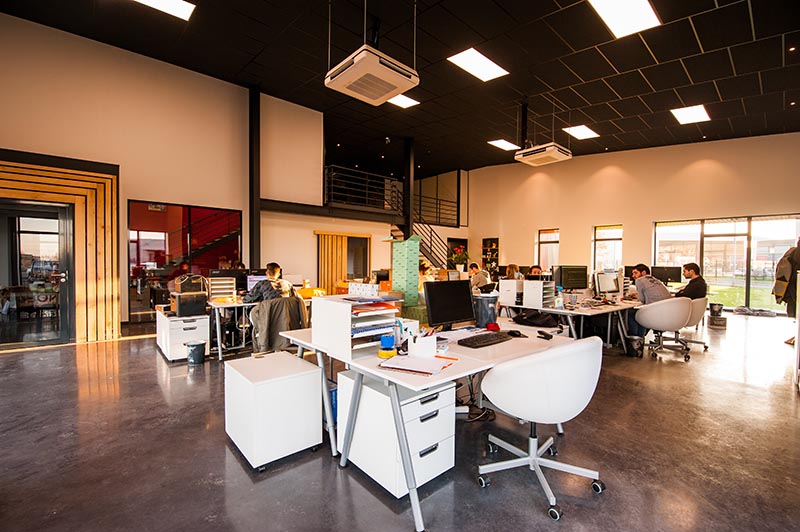
Trying to reduce the ecological impact of a business can seem like an ambitious yet challenging goal. Fortunately, there are simple ways to make a meaningful difference in your carbon footprint without affecting your ability to run an efficient operation. Let’s look at some areas where businesses can make easy but impactful changes.
Be an efficiency star
With approximately 35% of total greenhouse gas emissions coming from heat, electricity and other energy sources, the choices you make about how you use energy can make a significant difference. For instance, switching to energy-efficient appliances or using LED lighting can reduce your company’s energy usage, which will also result in savings.
Using a green web host is another easy way to focus on energy efficiency. Green hosting providers strive to use sustainable practices to reduce their impact on the environment by using eco-friendly data centers and servers. What’s more, they offset their carbon footprint and support the generation of renewable energy via investing in renewable energy credits.
Each time you purchase a new service or product, consider whether there is a selection that is a bit kinder to the planet. Looking for ENERGY STAR-certified options is a great place to start.
Travel light
With over one-quarter of greenhouse gas emissions coming from ground and air travel, transportation is an excellent area for optimization. Whenever possible, opt for a virtual conversation rather than a face-to-face meeting. You will save money on travel while also reducing your carbon footprint. Make your company’s energy policy to emphasize reducing business travel.
Consider offering a charging station for employees’ electric vehicles. You may also find ways to incentivize walking or bicycle commutes and carpooling. It often doesn’t take much to change your employees’ commuting choices. That cushy front-row parking space for carpoolers might be all it takes to motivate your employees to put one less vehicle on the road. Ensuring a secure spot to lock up a bicycle could be the thing that gets someone to pedal instead of pump gas. Some companies even offer free bicycles.
A step further would involve switching to electric trucks, if your business is related to logistics and transportation or offers delivery services. You can als look at your supply chain to ensure that you make smart vendor and partner choices. Over the last couple of years, we’ve seen major delivery companies adding electric vehicles to their fleets and committing to going 100% electric in the upcoming years, so electric vans and trucks are worth considering, no matter the business size.
If it works for your operations, consider adjusting schedules to reduce the number of trips your employees make. Occasional work-from-home days or a schedule of four ten-hour days instead of five eight-hour days means fewer trips and fewer harmful emissions.
Waste not, want not
There are many ways to reduce the amount of waste your company creates. Here are a few tips.
● Skip single-use plastics in the workplace. You can accomplish that with removing individual-serving plastic water bottles from the break room, to begin with.
● Maintain all equipment properly and on time so it doesn’t lose efficiency when you least expect it.
● Choose products that are packaged efficiently, minimizing the amount of plastic and cardboard that go to waste.
● Transition to digital records when possible. This saves on paper, ink, and ink cartridges. And when your ink cartridges do run dry, which inevitably seems to happen at the least convenient times, properly recycle them.
Shipping and receiving done right
Once you put the labels on and tape the boxes shut, you may not give your shipped items further thought. But how you get your products and other shipments to their final destinations can have a significant environmental impact.
Whenever possible, consolidate shipments and make sure every container is carefully packed to maximize capacity. When feasible, ship via ground instead of air since air travel is less fuel efficient.
For incoming shipments, consider ordering from businesses closer to home. That means less fuel is required to bring your supplies to you. Consolidate orders to receive fewer deliveries.
Look outside
It’s impossible to get your energy use to zero. However, one way to counteract the effects of the energy you do use is by supporting programs that reverse emissions. You can do that by purchasing renewable energy credits or carbon offsets. If you are unsure how to go about this, consider working with an energy consultant who can present you with options and help you lower your energy use and bills.
Watered down
Besides driving up your water bill, excess water use puts a strain on the environment. On top of that, such necessary procedures as heating water and processing wastewater use a significant amount of energy, which means that anything you can do to minimize the water coming out of taps is good for the planet. Aerated faucets, low-flow shower heads and other water fixtures, and water-saving or two-stage toilets all help keep usage down.
Lowering the temperature on your water heaters by even one or two degrees means you use less energy to keep that tank full of hot water. Also consider tankless water heaters that only heat water when you need it.
Summing up, you don’t need to overhaul your entire business to reduce the harm it does to the environment. Most of these changes are easy and low cost or even free. Some might even help you bring in new customers as more businesses seek ecologically conscious providers for their own goods and services. And you can sleep more easily knowing the business you love isn’t harming the planet you need.
Infographic
Reducing a business’s ecological impact may appear ambitious and daunting, but there are practical methods to achieve this goal without compromising operational efficiency. Making significant strides in reducing carbon footprints is possible through straightforward adjustments. Exploring these easily implementable changes in various aspects of business operations can lead to meaningful environmental benefits.

Video





